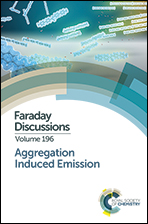Vapochromic features of new luminogens based on julolidine-containing styrene copolymers†
Abstract
We report on vapochromic films suitable for detecting volatile organic compounds (VOCs), based on new polystyrene copolymers containing julolidine fluorescent molecular rotors (JCAEM). Poly(styrene-co-hydroxyethylmethacrylate) copolymers functionalized with cyanovinyl-julolidine moieties of different compositions were prepared, (P(STY-co-JCAEM)(m) with m = 0.06–0.61). The sensing performance of the spin-coated copolymer films demonstrated significant vapochromism when exposed to VOCs characterized by high vapour pressure and a favourable interaction with the polymer matrix, such as Et2O and CH2Cl2. It is worth mentioning that the fluorescence decrease rate was 7 times faster than that of previously investigated julolidine-based fluorescent molecular rotors dispersed in PS films. This phenomenon was attributed to the better control of the JCAEM moiety distribution in the polymer matrix conferred by the covalent approach, combined with a minimal film thickness of 4 microns. These factors, in concert, strongly accelerate the deactivation pathways of the JCAEM units in the presence of VOCs which interact well. Overall, the present results support the use of julolidine-enriched styrene copolymers as effective chromogenic materials suitable for the fast detection of VOCs.
- This article is part of the themed collection: Aggregation Induced Emission


 Please wait while we load your content...
Please wait while we load your content...